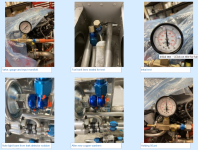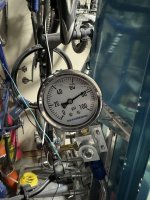Any suggestions on testing the fuel line connections on a 12iS build before mounting the tank? I have all the tubing lines made and installed. The fuselage is basically completed and I would like to leak test the system before loosing access to several of the fittings. The engine is hung and plumbed to the fuel system. Additionally, I have the appropriate AN fittings to cap the tubing. The wiring is not completed but I assume I can just the pumps with 12volts?? Any suggestions appreciated.
Van's Air Force
You are using an out of date browser. It may not display this or other websites correctly.
You should upgrade or use an alternative browser.
You should upgrade or use an alternative browser.
12iS Fuel system pressure test
- Thread starter KEG
- Start date
I think you should test for leaks with air before you try the pumps.Any suggestions on testing the fuel line connections on a 12iS build before mounting the tank? I have all the tubing lines made and installed. The fuselage is basically completed and I would like to leak test the system before loosing access to several of the fittings. The engine is hung and plumbed to the fuel system. Additionally, I have the appropriate AN fittings to cap the tubing. The wiring is not completed but I assume I can just the pumps with 12volts?? Any suggestions appreciated.
I installed the tank before the engine, so was able to test at the two fittings that emerge from the firewall (supply & return): bicycle-type valve on one, cap on the other, nitrile glove on the fuel tank where the filler port would be. The last was the most difficult to get a good seal. If you have installed the fuel tank inspection port, that would be another place you could pressurize. If you haven't installed the tank yet. you could make a test stub (bicycle tire valve, rubber tube, short aluminum fuel line, adapters as needed) at test at the supply & return fittings that go into the bottom of the tank. If you do have the tank in place, be careful to use very little pressure (just enough to inflate the glove), and note very small differences in temperature can make the glove inflate/deflate -- I could make the change just by putting my hand on the tank.
henrysamson
Member
I did a leak test on my RV-12iS fuel system after all of the main lines were in but before the engine arrived. So, no engine and no fuel pumps. So, none of the fuel pump and fuel filter fuel interconnect lines were installed.
I capped the fuel supply line that connects to the main filter at the filter end. I removed the fuel tank and capped the fuel return line that connects to the tank. At the firewall I capped one line and placed a pressure gauge with a tire valve to the other. I was then able to pressurize the system and check for leaks. The fuel supply and return lines are connected through a small orifice in the bypass fitting so both sides of the system, supply and return, can now be pressurized.
Yes, I found some leaks. I was able to trouble shoot using a spray bottle with soapy water. I would pressurize and then if the pressure had dropped I checked for bubbles at the fittings. At the end the system held 55 psi for several days. I figured that even though this did not test the entire system it did test lines and fittings that will be very difficult to work on after the controls, engine and avionics are installed.
Later, after the pumps were installed I performed a similar test of the system with those lines installed. Again, without the tank.
I'm not sure if the pumps will pressurize a dry system. I don't want to run my pumps dry in any event. After installation of the pumps and avionics/electrical system I turned each on for a second or two just to verify the wiring and connections. I don't plan to run them again until there is fuel in the system.
Henry
I capped the fuel supply line that connects to the main filter at the filter end. I removed the fuel tank and capped the fuel return line that connects to the tank. At the firewall I capped one line and placed a pressure gauge with a tire valve to the other. I was then able to pressurize the system and check for leaks. The fuel supply and return lines are connected through a small orifice in the bypass fitting so both sides of the system, supply and return, can now be pressurized.
Yes, I found some leaks. I was able to trouble shoot using a spray bottle with soapy water. I would pressurize and then if the pressure had dropped I checked for bubbles at the fittings. At the end the system held 55 psi for several days. I figured that even though this did not test the entire system it did test lines and fittings that will be very difficult to work on after the controls, engine and avionics are installed.
Later, after the pumps were installed I performed a similar test of the system with those lines installed. Again, without the tank.
I'm not sure if the pumps will pressurize a dry system. I don't want to run my pumps dry in any event. After installation of the pumps and avionics/electrical system I turned each on for a second or two just to verify the wiring and connections. I don't plan to run them again until there is fuel in the system.
Henry
Last edited:
I purchased a few items on Amazon - a gauge, some brass fittings, etc. to create a combo Schrader valve, pressure gauge, input source manifold plus bought a few flare fittings and caps to seal up open fuel tank lines for pressure test. I tested lines including fuel pumps and associated on back bulkhead but NOT including the fuel tank. The test fitting was connected to a fuel supply line coming off of the firewall; the return fitting on the firewall was capped.
The initial test at 45 psi but a small leak. I could hear a slight hiss in the area of the fuel pumps and applied some leak detector solution, a very tiny leak was located at a copper washer in the banjo bolt to fuel filter joint on the rear bulkhead pump/filter assembly.
I replaced 2 of the 3 copper washers in the banjo fitting and this did the trick. Note: I believe these copper washers have been updated by Van's with a newer washer with a rubber seal on the inner opening. After replacing the washers, I kept the system test in place for 24 hours to ensure it was tight, holding 50 psi and ready to go.
David Grady

The initial test at 45 psi but a small leak. I could hear a slight hiss in the area of the fuel pumps and applied some leak detector solution, a very tiny leak was located at a copper washer in the banjo bolt to fuel filter joint on the rear bulkhead pump/filter assembly.
I replaced 2 of the 3 copper washers in the banjo fitting and this did the trick. Note: I believe these copper washers have been updated by Van's with a newer washer with a rubber seal on the inner opening. After replacing the washers, I kept the system test in place for 24 hours to ensure it was tight, holding 50 psi and ready to go.
David Grady

Rv-12David
Member
Used some bits and pieces from the kit plus an Amazon pressure gauge. Tested the basic fuel lines minus the pumps etc as I don’t have the engine yet. Looking at the lines that run up the back of the fire wall catching leaks before the pedals etc are installed was a good idea. It took a few tries to get it leak free. Mine held 80 psi - about double working pressure - for a week.





